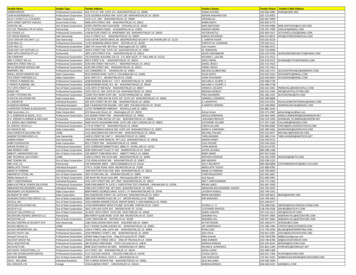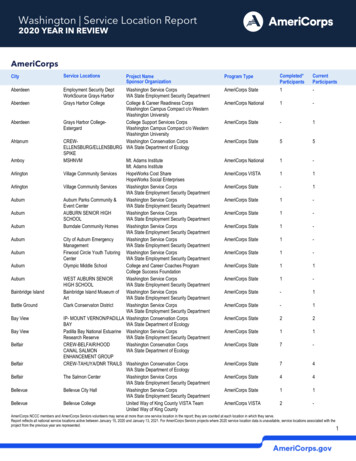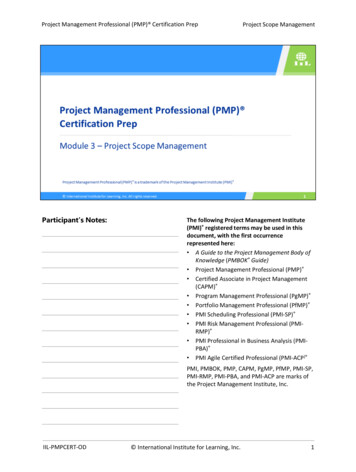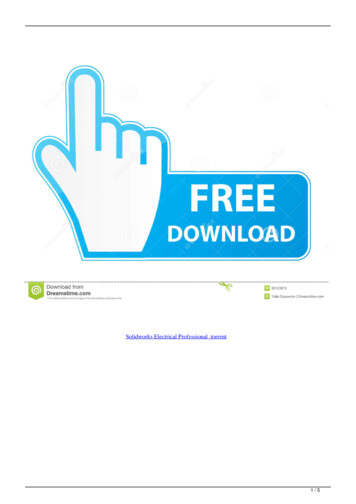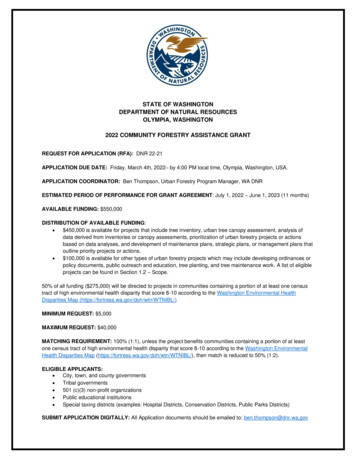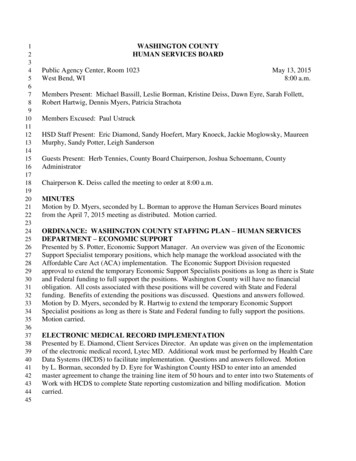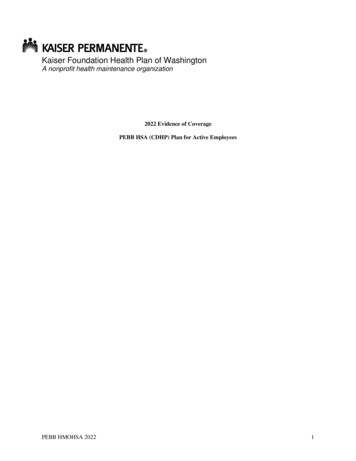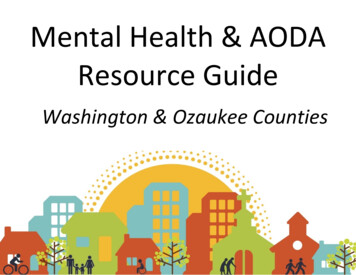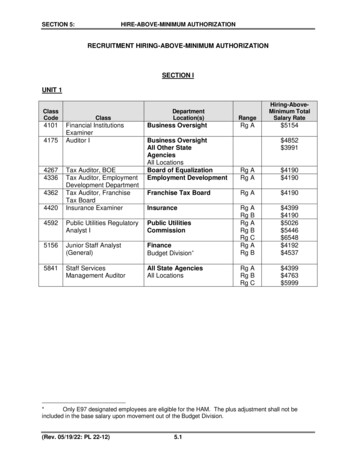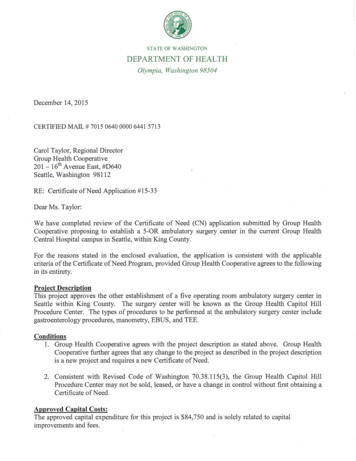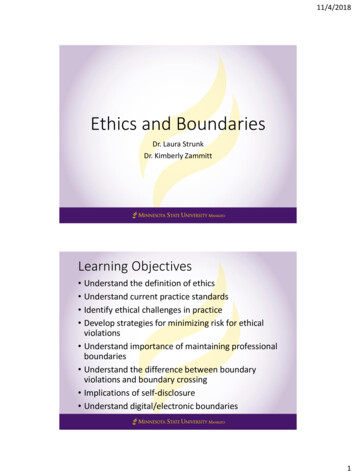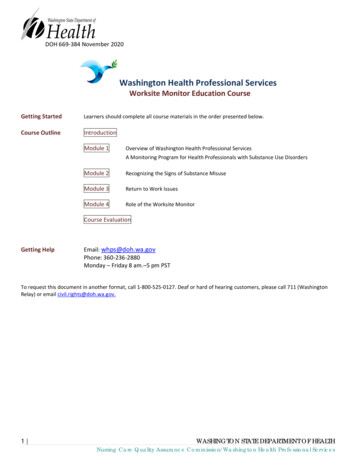
Transcription
DOH 669-384 November 2020Washington Health Professional ServicesWorksite Monitor Education CourseGetting StartedLearners should complete all course materials in the order presented below.Course OutlineIntroductionModule 1Overview of Washington Health Professional ServicesA Monitoring Program for Health Professionals with Substance Use DisordersModule 2Recognizing the Signs of Substance MisuseModule 3Return to Work IssuesModule 4Role of the Worksite MonitorCourse EvaluationGetting HelpEmail: whps@doh.wa.govPhone: 360-236-2880Monday – Friday 8 am.–5 pm PSTTo request this document in another format, call 1-800-525-0127. Deaf or hard of hearing customers, please call 711 (WashingtonRelay) or email civil.rights@doh.wa.gov.1 WASHINGTON STATE DEPARTMENT OF HEALTHNursing Care Quality Assurance Commission/Washington Health Professional Services
DOH 669-384 November 2020Worksite Monitor Education CourseIntroductionWashington Health Professional Services (WHPS) is a monitoring program designed for nurses with substance usedisorders. Although not a treatment program, the focus is on early detection and treatment of nurses experiencingalcohol and/or other drug problems. Our mission is to promote early intervention and treatment, safely return the nurseback to practice, and provide effective monitoring in order to ensure public safety and confidence. We accomplish thismission by contracting with and monitoring nurses for compliance with treatment and recovery goals.WHPS supports the return to employment under specific conditions. Before approving employment, the WHPS teamevaluates the professional’s stability in recovery, compliance with the monitoring contract, and ability to practice in asafe and competent manner. Employment approval and monitoring almost always includes a set of work restrictions asan added safety measure. These restrictions may be lessened or modified over the course of the contract.As a worksite monitor, you play a pivotal role in the monitoring of WHPS nurses. All nurses in the WHPS program arerequired to have a monitor in the worksite in order to return to practice. To serve in the capacity of a worksitemonitor, one must be in professional service in a supervisory or senior role. Worksite monitors are in a unique positionto assist recovering healthcare professionals remain in the workforce and to ensure patient safety through a program ofclose monitoring.The worksite monitor may be the only person monitoring the WHPS nurse at the worksite. Yours is a critical role towardensuring patient and public safety, as well as a safe environment for the nurse.Other WHPS requirements include but are not limited to random drug screening, and involvement with support groups.Non-compliance with any area of the nurse’s WHPS monitoring contract is taken very seriously. It is our goal to identifyearly signs of potential relapse, and to work with the nurse and the employer to address any issues. We want to assurethat all WHPS nurses are practicing their profession safely and competently.Nurses engaged in monitoring most often do well when employed. Worksite monitoring is an integral part of theirrecovery program. We ask that you accept the responsibility as worksite monitor with the diligence and sensitivity itdeserves, allowing nurses to return or continue to practice their profession in a way that safeguards the public.WHPS case managers are available to meet with you to discuss the program and to answer any questions or concernsthat arise. To speak directly with a case manager, please call 360-236-2880.Please direct further questions to:2 John Furman, Assistant Directorjohn.furman@doh.wa.govPhone 306-236-2880.WASHINGTON STATE DEPARTMENT OF HEALTHNursing Care Quality Assurance Commission/Washington Health Professional Services
DOH 669-384 November 2020Worksite Monitor Education CourseModule 1: Overview of Washington Health Professional Services – A MonitoringProgram for Health Professionals with Substance Use DisordersFOUNDATIONIt is difficult to ascertain the number of nurses with substance use disorders because it is difficult to measure thosethings many people do not want to talk about. Further, the nurse is not likely to step forward to be identified for fear oflicense discipline and public exposure. If one applies the generally accepted statistic of 10 percent, we can estimate thenumber of nurses personally affected by substance abuse in our state at any given time is approximately 11,000,000. It isoften difficult for healthcare professionals to report the suspicion of alcohol or drug misuse in a colleague and evenmore difficult to recognize it in themselves. In order to break through what has been termed a conspiracy of silence, itis important that healthcare organizations provide education and establish clear, accessible policies that take a nonpunitive approach to addressing substance misuse.Washington Health Professional Services (WHPS) provides a structured approach to the regulatory monitoring of healthprofessions with substance use disorders, protects public safety, and provides for uniform accountability. Substance usemonitoring services have been provided to more than 5,000 nurses and other health professionals since 1988.LEGISLATIVE INTENTWashington Health Professional Services (WHPS) provides comprehensive statewide professional intervention, referraland monitoring services to nurses with substance use disorders in accordance with RCW 18.130.175. The legislaturespecifically intends that:“ disciplining authorities seek ways to identify and support the rehabilitation of health professionals whose practice orcompetency may be impaired due to the abuse of drugs or alcohol. The legislature intends that such health professionalsbe treated so that they can return to or continue to practice their profession in a way which safeguards the public.”PROGRAM OVERVIEWIn 1988, the Substance Abuse Monitoring Program (SAMP) was developed in partnership with the Board of Nursing (nowthe Nursing Care Quality Assurance Commission). Washington Health Professional Services was established in 1991, asan independent program and expanded its services to include more than 70 licensed health professions. In December2015 WHPS became the sole service provider to the nursing professions (LPN, RN, ARNP, and CRNA).WHPS is a voluntary referral and monitoring program designed as an alternative to license discipline. Although not atreatment program, the focus is on early detection and treatment of nurses experiencing alcohol and/or drug problems.WHPS is a confidential resource, to the maximum extent provided by law, for nurses, employers, and colleagues whohave concerns that a nurse might be at risk for potential impairment. Access to records is limited to program staff and isprotected from public disclosure. If a nurse is referred by a licensing or certification board or commission, complianceinformation may be released to that board or commission as necessary to monitor compliance.3 WASHINGTON STATE DEPARTMENT OF HEALTHNursing Care Quality Assurance Commission/Washington Health Professional Services
DOH 669-384 November 2020The confidentiality of WHPS nurses is protected by state and federal law; Revised Code of Washington (RCW) 18.130.175and 42 CFR Part 2. Nurses can feel secure that their identity and personal health information is protected from publicscrutiny.MISSION STATEMENTWashington Health Professional Services works to protect and improve the health of people in Washington State bysupporting early intervention, safe return to practice, and providing effective monitoring of nurses with substance usedisorders.VISION STATEMENTTo continue to be a leader in the monitoring of nurses with substance use disorders by using current research and bestpractices in order to most effectively allow nurses to return or continue to practice their profession in a way thatsafeguards the public.VALUES We honor the public’s trust and maintain a commitment to public safetyWe recognize the right of everyone to be treated with dignity and respectWe are accountable, effective and responsiveWe act in integrity and the courage to changeWe protect confidentiality to the maximum extend of the lawWe work collaboratively with partners and communities to support the WHPS missionNurses may enter WHPS by contacting the program directly or through a referral from the Nursing Commission. TheNursing Commission becomes involved when a complaint has been made regarding the performance and behavior ofthe nurse. An investigation is conducted and all due process requirements are followed. Disciplinary action may or maynot be taken depending on the facts of the case and nurses are often offered the opportunity to enter WHPS in lieu ofdiscipline. Non-compliance with program requirements may result in disciplinary action, including license suspensionuntil such time as the nurse can demonstrate good cause why the license should be returned. Factors that influencedisciplinary action include but are not limited to practicing under the influence of alcohol or other drugs, diversion ofdrugs from the workplace, drug substitution or alteration, and any other actions that place the public at risk.PROGRAM SERVICESWHPS develops individualized monitoring contracts that outline the terms and conditions of the nurse’s participation.Program services are facilitated in the following ways: Case development Referrals for a substance use evaluation and/or treatmentDocumented continuing care planCoordination of treatment resources Contract for Program Participation 4 Partnership with employers and worksite monitorsReferrals for mental health, pain management and other servicesReferrals to professional peer support groupsWASHINGTON STATE DEPARTMENT OF HEALTHNursing Care Quality Assurance Commission/Washington Health Professional Services
DOH 669-384 November 2020 Practice restrictionsRandom drug screeningFiling of reports to document compliance Outreach and education Participation in conferencesConsultation to employers, in-service trainings and intervention optionsAssistance with drug free workplace policy developmentDevelopment of educational opportunities for program nurses Consultation with other states and regulatory entities WHPS has been a leader in developing alternative to discipline programs on the national level andcontinues to participate in efforts to support research and establish best practicesMore information about the WHPS program is on the Department of Health website at www.doh.wa.gov/whps or call usat 360-236-2880.5 WASHINGTON STATE DEPARTMENT OF HEALTHNursing Care Quality Assurance Commission/Washington Health Professional Services
DOH 669-384 November 2020Worksite Monitor Education CourseModule 2: Recognizing the Signs of Substance MisuseRECOGNIZING THE SIGNS OF SUBSTANCE MISUSE StagesRecognizing impaired practice – behavioral signsSigns that the nurse may be diverting and/or usingResponding to suspected substance abuse in the workplaceI. StagesDependency does not become full blown at first use. As a worksite monitor, it is important for you to understand thatphysical and psychological dependence evolves in stages. The stages include:Stage One: ExperimentationThe first stage, experimentation, is the voluntary use of alcohol or other drugs. Quite frequently, the personexperimenting is trying to erase another problem. An older person may start drinking to cope with depression afterlosing a spouse. A teenager, angry about his parents’ divorce, could start smoking marijuana or huffinginhalants. Experimentation may even include a husband taking his wife’s prescription painkillers to cope with a backproblem. The substance seems solve the problem. So, the person takes more, and moves from experimentation toregular use, the next stage.Stage Two: Regular UseSome people stay in the regular use stage indefinitely. They will not develop a problem and stop by themselves. Othersstart using substances in a manner that is risky or hazardous to themselves or to others. Risky behaviors include smokingmarijuana and driving; binge drinking (consuming more than the recommended amount of alcohol at one occasion); andunexplained violence, to one’s self or another.Stage Three: Risky UseWhen and how the transition from regular too risky use happens differs for every person. So, what constitutes “riskybehavior” by another person can be difficult to gauge. Just the same, if someone’s behavior concerns you, say so. Peoplecan pass quickly from risky use to dependence.Stage Four: DependenceCharacteristics of dependence include: Repeated use of alcohol or other drugs that leads to failure to fulfill majorresponsibilities related to work, family, school or other roles; repeatedly drinking or using drugs in situations that arephysically hazardous, such as driving while intoxicated or using heavy machinery when intoxicated; repeated legalproblems; and/or any combination of these.Many dependent people can work, maintain family relationships and friendships, and limit their use of alcohol or otherdrugs to certain time periods, such as evenings or weekends.6 WASHINGTON STATE DEPARTMENT OF HEALTHNursing Care Quality Assurance Commission/Washington Health Professional Services
DOH 669-384 November 2020Stage Five: AddictionThe last phase of the spectrum of substance use problems is addiction. Addiction is a medical condition involving seriouspsychological and physical changes from repeated heavy use of alcohol, other drugs, or both. Symptoms include uncontrollable alcohol or other drug craving, seeking, and use, that persists even in the faceof negative consequences. Addiction is a progressive illness. If left untreated, it gets worse. It is also chronic, or long-standing (versus acute,or short-term). Addiction is a treatable illness. Recovery rates for people who go through treatment are very similar to thosewho get treatment for other chronic diseases such as diabetes and asthma. There are several treatmentmethods and community resources, including outpatient or residential treatment programs and 12-step groups.These approaches can be customized to fit the needs of the person and family.RecoveryThe recovery stage begins when a substance-dependent person discontinues the use of drugs. Physical recovery occursbefore emotional growth and recovery. Substance-dependent people who discontinue drug use must learn healthy waysto deal with anguish and pain. Destructive habits must be replaced with healthy ones. Emotional growth comes fromfacing up to stressful events and consistently trying to improve. Many substance-dependent professionals describerecovery as a spiritual awakening. As the substance-dependent person recovers, family issues frequently mend andthere are successes at work. Many substance dependent people find a high level of support when they transition back towork and develop new associates and service opportunities.II. Recognizing Impaired Practice – Behavioral SignsThe first step in assisting a colleague is recognition: Substance misuse should not be presumed by a single sign orsymptom, but rather by changes in behavior and job performance. Because nurses define themselves by theirprofession, evidence of the disease on the job often indicates a late stage of illness. Workplace problems are a last stepin a downward spiral. Often coworkers are shocked when the illness is uncovered. Fear of punishment and bad pressaffects everyone, which perpetuates a code of silence that prevents professionals from receiving the help they need torecover.WHPS has identified guidelines to assist employers in recognizing substance abuse in the workplace. These guidelinesare divided into pre-employment and employment indicators.Pre-Employment IndicatorsSubstance use disorder should not be presumed by a single indicator, but rather by changes in behavior.7 Numerous job changes in last three to fiveyears Inappropriate references Frequent relo
As a worksite monitor, you play a pivotal role in the monitoring of WHPS nurses. All nurses in the WHPS program are required to have a monitor in the worksite in order to return to practice. To serve in the capacity of a worksite monitor, one must be in professional service in a supervisory or senior role. Worksite monitors are in a unique position
